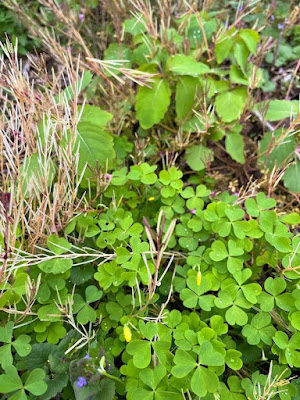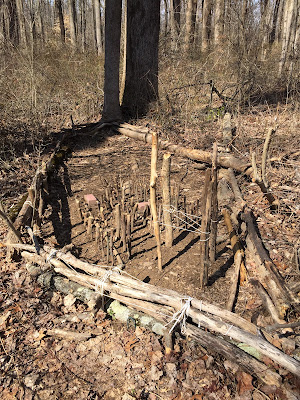News from the preserves, parks and backyards of Princeton, NJ. The website aims to acquaint Princetonians with our shared natural heritage and the benefits of restoring native diversity and beauty to the many preserved lands in and around Princeton.
Thursday, May 19, 2022
Weeds that Launch an Underground Insurgency
Sunday, May 08, 2022
Mother's Day's Complicated History With Flowers
Following the carnage of the Civil War, and before Anna Jarvis entered the scene, there had been efforts to celebrate mothers as a force in the world for peaceful settlement of differences, but none of the events had evolved into a tradition.
The death of Anna Jarvis's mother on the second Sunday in May, 1905, spurred Anna into action. Nine years of advocacy ultimately led to Woodrow Wilson's signature proclaiming an official Mother's Day in 1914, just in time for the outbreak of WWI several months later. Note the placement of the apostrophe. Rather than a celebration of mothers in general, Anna's vision was a very personal affair, in which people would give handwritten notes expressing gratitude for all that their own mothers had done for them. Anna distributed white carnations at the first formal Mother's Day event in 1908, but ultimately would spend the rest of her life fighting the commercialization of the day by the florist, card, and candy industries.
To honor the brave founder of the holiday, therefore, it looks like the best course of action would be to write a note of personal gratitude on something other than a Mother's Day gift card, perhaps accompanied by some flowers cut from the backyard. Lilacs, anyone? That could be followed by a stroll past some gardens with flowers in bloom.
Below are a random assortment of flowers that you might encounter, though the reader is to be discouraged from picking unless they are growing in your own yard.
A few from my own yard. This is Siberian bugloss, which is often confused withforget-me-nots, which are paler, less robust, and have much smaller leaves.Witch Alder (Fothergilla) is an attractive native shrub that I haven't seen growing naturally in our area but is available in nurseries.
These native azaleas, nurtured in the Barden at Herrontown Woods, have probably popped open by now. An experienced gardener sees the full bloom even in partially opened flowers.
Up at the Veblen House, where the flora shift from native towards English garden, people ask what these pretty white or blue flowers are that spread across the lawn. Ajuga--a member of the mint family. Some people call it bugleweed.
Ever seen these and wondered what they were? So have I. Fritillarias have persisted in the Veblen garden from at least the 1970s,
along with a few primrose.
Thursday, May 05, 2022
An Explosion of Spring Weeds
First step, photograph them and write about them, on the chance that others might too find themselves wading through a backyard full of weeds and wonder what they all are. Click on a photo to make it larger.
This one, the most ridiculously successful, is purple deadnettle. It's in the mint family, which you can tell by its square stem, but unlike many other mints, it relies on seeds to spread, rather than underground rhizomes.
Here's more purple deadnettle, with a foreground of ground ivy. Ground ivy has other names: creeping Charlie, and gill over the ground. It spreads vegetatively above ground, across lawns, into garden beds. It could be charming if it weren't so aggressive. The same can be said for mock strawberry.Here's the ground ivy mixed in with some white clover at the bottom of the photo. The white clover hasn't been a problem, but in some situations, it too can become a sprawling mass.Ground ivy looks like a wave here, rising out of the lawn and swamping the stonecrop Sedums. I really like the dandelions, until they go to seed, then not so much. If the soil is soft, gather all the basal leaves in your hand and give a slow, steady pull. Feed the leaves to your guinea pigs. Do people still have guinea pigs as pets?
By now, you'll recognize the ground ivy at the bottom of the photo, the purple dead nettle in the middle. Equally prevalent is hairy bittercress, which is the now brown plant in the upper left. A gardener feels a sense of defeat when, having delayed too long in pulling the hairy bittercress, its seeds come flying up at your face. It feels like mockery, the plant having successfully completed its life cycle and populated the ground with seeds for yet another year.
Mugwort, down there at the bottom, is a tough customer that has taken over many gardens, raingardens, and fields. Recurrent pulling has limited it to one place in my garden, but it spreads to form monocultures along the gas pipeline right of way along the Princeton ridge. Above and left in the photo is a kind of horsetail that has inculcated itself into one of the flower beds, probably planted decades ago by a previous owner.
it exploded this year and became, like so many problems in the world, too much of a good thing.
Curly dock is easy to undercut with a shovel.
Another weed that's here and there and can easily be pulled from wet ground is rough avens. To its left in the photo is a native weed called willow herb. Both of these look like they might generate attractive flowers, but don't quite generate enough show to be considered ornamental.
Friday, April 15, 2022
Lesser Celandine Alert!
Blooming in many people’s yards right now is a small yellow flower that, upon closer inspection, proves not to be a dandelion. Variously called lesser celandine or fig buttercup, its radical invasiveness triggers a predictable progression of emotions in the homeowner. Delight at its pretty flower soon turns to alarm as year by year it takes over the yard, spreading through flower beds, across lawns and into neighboring properties. What may start as a few scattered, harmless-seeming clumps quickly becomes the equivalent of a rash upon the landscape. Unlike the dandelion, lesser celandine also spreads into nature preserves. Poisonous to wildlife, it forms thick stands reminiscent of pavement. Over time, our nature preserves become less and less edible to the wildlife they were meant to support. Native diversity shifts towards non-native monoculture.
Below are some photos to help with identification, and here is a link that includes suggested means of stopping it from taking over your yard. Though the link says only to spray through early April, I'd suggest that spraying is helpful for as long as its leaves are green. Lesser celandine is a spring ephemeral, meaning that it comes up early, then dies back in June, going dormant until the next spring. Gardeners who like to dig up plants of this or that to give to friends should be aware that, if their yards have been invaded by lesser celandine, some of it may hitchhike in whatever plants they dig up later in the season to give away. They may unwittingly be giving a fellow gardener the beginnings of a major headache.
Lesser celandine is poisonous, and yet some websites declare it edible and offer recipes. Why the contradiction? Apparently, lesser celandine accumulates toxins later in the spring. The toxins break down during cooking or after drying. Still, one takes one's chances trying to eat it, and, alas, wildlife don't cook.
I've seen bees collecting pollen and nectar from the flowers, which is all fine and good, but this doesn't compensate for the inedibility of the leaves. The invasion of our lands by nonnative plants that wildlife don't eat essentially shrinks the acreage of functional habitat in Princeton, even though a great deal of open space has been preserved. Thus the need for management.
Given that some areas of Princeton have been overrun by lesser celandine, it's important to defend those areas that have not, by closely monitoring and spot spraying where the plant is just starting to move in. Invasions begin with just a few plants here and there. An absolute minimum of herbicide is needed to easily defend these areas. Lesser celandine can easily be distinguished from dandelion. Walk the grounds before the grass gets mowed in the spring and while the plant is blooming. For lawns, a product like Weed B Gone works. For other areas, a 2% solution of glyphosate does the trick. Since glyphosate can take a week to show visible effect on the plant, it's best to spray early in the spring so that there's time to see results and spray any areas missed. For those near wetlands, wetland-safe formulations of glyphosate are available, so Roundup is not the only option.
In terms of aesthetics, lesser celandine's dense, exclusionary growth does to the landscape what people badly afflicted with narcissism do to social situations. A woodland that once hosted a diversity of native wildflowers becomes, when overwhelmed by lesser celandine, one species' declaration of Me! Me! Me!
Friday, April 01, 2022
Finding Native Swamp Rose Amidst the Multiflora Rose
For those who need deadlines, the last cold days of spring are a prompt for action by a wild gardener. It's the last chance to get some work done in a nature preserve without having to worry about doing tick-checks. It's also a time when leaves have yet to dampen the light pouring into the forest, and the invasive shrubs are still in their less intimidating winter dormancy.
Scott Sillars and I took advantage of a cool afternoon this week to cut invasive multiflora rose and privet at Herrontown Woods. There is constant surprise in how this awkward, gutsy work is way more satisfying than it has any right to be. Though rose-rosette disease has reduced its rampancy, multiflora rose is still a highly invasive shrub in Princeton forests. With its gangly growth, the sprawling shrub can best be described as a blizzard of thorns, whose introduction from Asia long ago has rendered many forests impenetrable. Cutting it down, I'm always reminded of the many-armed "omnidroid" monster in The Incredibles movie. But the way to emerge unscathed from a multiflora rose cutting session is to be gentle and methodical. Cut enough of the gangly stems to gain access to the center of the shrub, then reach in to cut its multiple stems at the base. Extract yourself carefully from the situation, and if your heavy clothing (another advantage of cool weather) gets snagged by a thorn, rotate to loosen the fishhook thorns or cut the clinging stem so that it will fall off on its own. What seems like rough work is actually an opportunity to exercise finesse.Sunday, March 27, 2022
Some Spring Sightings at Herrontown Woods
The boulders along the ridge are rounded, composed of diabase, which in my experience is associated with rare plant species that thrive in the particular kind of soil generated from the weathering of these rocks. The boulders were not deposited here by glaciers, but instead formed from molten upwellings from below. In Herrontown Woods and Autumn Hill Reservation there are numerous little abandoned quarries where some of the larger boulders were split into chunks and hauled away.























































